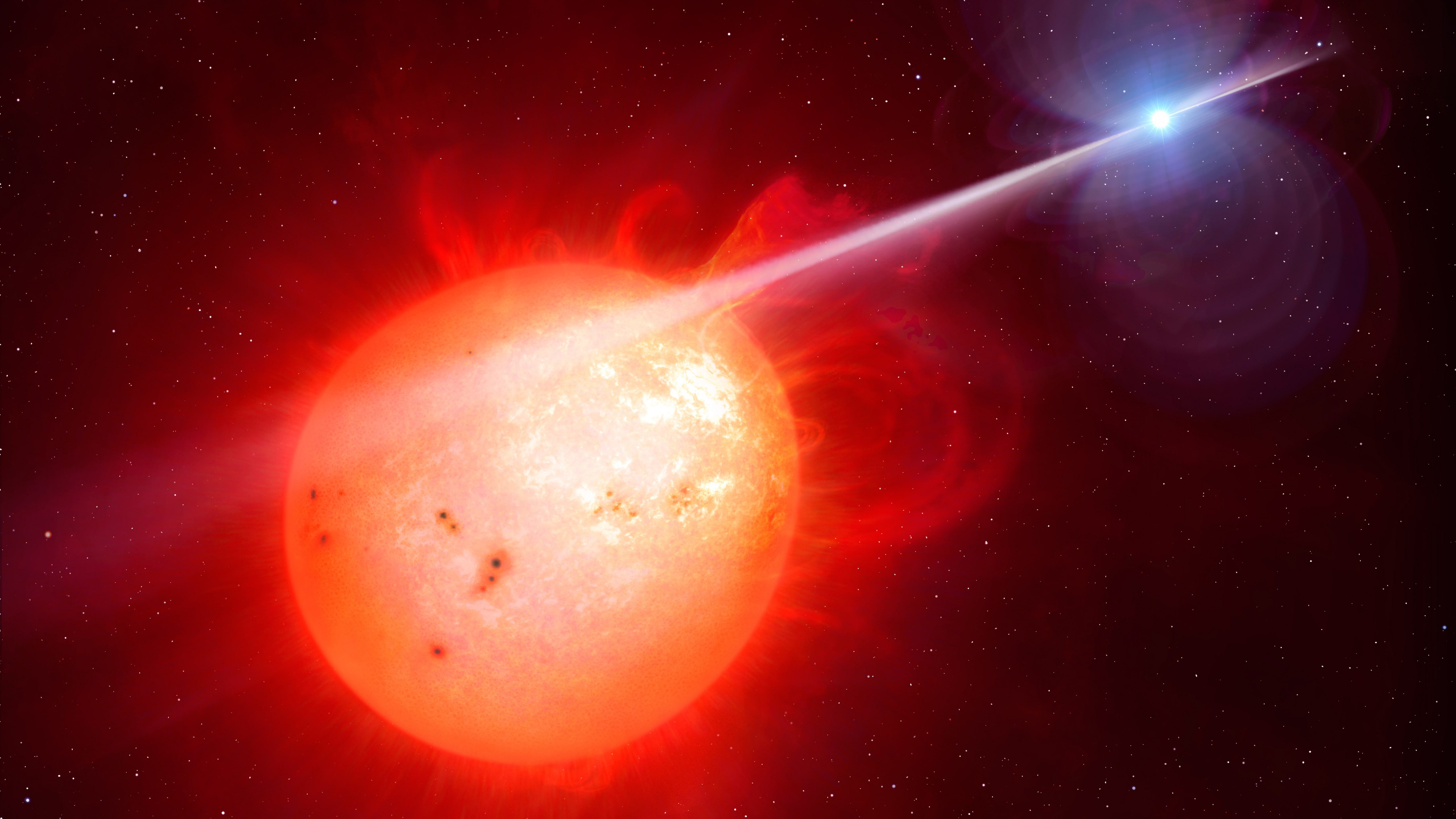Scientists Stumped By Strange Pulsing Phenomenon In Deep Space

Table of Contents
The Nature of the Pulsing Phenomenon
The strange pulsing phenomenon is characterized by rhythmic bursts of energy, detected primarily as radio waves, though some faint optical counterparts are being investigated. The signals exhibit a remarkable degree of periodicity, with pulsations occurring at intervals ranging from milliseconds to seconds, though significant irregularities are also observed.
Frequency and Pattern Analysis
Analyzing the precise frequency and pattern of these periodic pulsations is crucial to understanding their origin.
- Data Collected: Observations have been made using a variety of radio telescopes around the globe, collecting data on the signal's intensity, frequency, and polarization. Light curves are being meticulously charted to pinpoint any subtle variations.
- Observed Patterns: While a basic periodicity is observed, there are significant variations in the intensity and duration of individual pulses. These irregularities complicate attempts to develop a comprehensive model.
- Mathematical Modeling: Scientists are employing sophisticated algorithms and statistical methods to analyze the data, attempting to identify underlying patterns and potentially predict future pulses. The challenge lies in distinguishing genuine variations from noise. The hope is to find mathematical patterns that could suggest a physical mechanism. Research into this strange pulsing phenomenon involves many disciplines.
Potential Sources of the Pulsations
The origin of these mysterious signals remains highly speculative, with several hypotheses being explored.
- Neutron Stars/Pulsars: One leading theory suggests the pulsations could originate from a highly magnetized neutron star, a type of stellar remnant known as a magnetar, though the observed characteristics differ somewhat from known magnetar activity. The regular pulsations could arise from rotational variations.
- Fast Radio Bursts (FRBs): The signals share some similarities with Fast Radio Bursts (FRBs), intense, brief bursts of radio waves from deep space, but the periodicity distinguishes them. Could this be a previously unknown type of FRB?
- Unknown Celestial Objects: The possibility of entirely new, previously unknown celestial objects generating these pulsations cannot be ruled out. This would require a fundamental shift in our understanding of astrophysics.
- Extraterrestrial Signals: While highly speculative, the regularity of the pulses has led some to consider – albeit cautiously – the possibility of an extraterrestrial origin. This is considered a less likely but intriguing possibility in the current state of the research.
Technological Challenges and Observational Limitations
Investigating this strange pulsing phenomenon presents several significant technological hurdles.
Distance and Signal Attenuation
The vast distances involved present a considerable challenge.
- Signal Weakening: The signals undergo significant attenuation as they travel across interstellar space, meaning that much of the original signal's information is lost before it reaches our telescopes.
- Interference: Distinguishing the signals from terrestrial and cosmic interference (e.g., radio noise from satellites or galactic sources) requires highly sophisticated signal processing techniques.
- Telescope Technology: While current telescopes are capable of detecting the pulses, more advanced technologies will be needed to resolve finer details and obtain clearer signals. Next-generation telescopes could help in understanding the nature of this deep space phenomenon.
Data Acquisition and Interpretation
Collecting and interpreting the data requires a massive international collaborative effort.
- Data Analysis: The sheer volume of data generated requires advanced computational tools and data analysis techniques to sift through the noise and identify meaningful patterns.
- Scientific Collaboration: Scientists worldwide are pooling their resources and expertise to analyze the data and explore different hypotheses about the signals' origin.
- Signal Processing: Advanced signal processing techniques are necessary to filter out interference and enhance the faint signals from deep space.
Implications and Future Research
This strange pulsing phenomenon could have profound implications for our understanding of the universe.
Expanding Our Understanding of the Universe
Unraveling the mystery of this pulsing phenomenon could lead to significant breakthroughs in astrophysics and cosmology.
- Neutron Star Physics: Understanding the origin of the pulsations may offer invaluable insights into the behavior of neutron stars, particularly concerning their magnetic fields and rotational dynamics.
- Fundamental Physics: The discovery may reveal new physics beyond the current theoretical framework, possibly influencing our understanding of gravity or other fundamental forces.
- New Celestial Objects: The identification of an entirely new class of celestial object would fundamentally shift our understanding of the Universe and its composition.
Upcoming Research and Observational Campaigns
Several research initiatives are planned to further investigate this remarkable discovery.
- New Telescopes: Next-generation telescopes, such as the Square Kilometre Array (SKA), will provide significantly improved sensitivity and resolution, enabling more detailed observations.
- Upgraded Technology: Advancements in signal processing techniques and data analysis algorithms will be instrumental in enhancing the quality of the data and improving the interpretation.
- International Collaborations: International collaboration between astronomers and physicists is essential for pooling resources, sharing data, and accelerating the pace of research. This deep space phenomenon requires a collaborative approach.
Conclusion
The strange pulsing phenomenon in deep space presents a compelling puzzle, highlighting the vast unknowns that remain in our universe. While several hypotheses have been proposed, the precise origin and nature of these mysterious signals remain elusive. However, ongoing research and upcoming observational campaigns promise to illuminate the mystery of this pulsing phenomenon, perhaps uncovering groundbreaking discoveries about the cosmos. To stay updated on the latest developments, follow leading scientific journals, organizations like NASA and ESA, and reputable news sources covering astrophysical breakthroughs. Further exploration of this deep space anomaly is crucial to understanding its nature and unlocking the secrets it holds. The ongoing intrigue surrounding this pulsing phenomenon ensures continued fascination and the potential for transformative scientific advancements.

Featured Posts
-
 The Booming Vaccine Packaging Market Trends And Opportunities
May 30, 2025
The Booming Vaccine Packaging Market Trends And Opportunities
May 30, 2025 -
 M Net Firmenlauf Augsburg Alle Infos Zum Heutigen Lauf
May 30, 2025
M Net Firmenlauf Augsburg Alle Infos Zum Heutigen Lauf
May 30, 2025 -
 Agassi Dezvaluie Stresul Incredibil De La Meciuri
May 30, 2025
Agassi Dezvaluie Stresul Incredibil De La Meciuri
May 30, 2025 -
 Proceso De Reembolso Ticketmaster Festival Axe Ceremonia 2025 Cancelado
May 30, 2025
Proceso De Reembolso Ticketmaster Festival Axe Ceremonia 2025 Cancelado
May 30, 2025 -
 Medvedev Stumbles Djokovic Advances French Open Day 2 Recap
May 30, 2025
Medvedev Stumbles Djokovic Advances French Open Day 2 Recap
May 30, 2025
Latest Posts
-
 Cycling Team Victorious Ready To Conquer The Tour Of The Alps
May 31, 2025
Cycling Team Victorious Ready To Conquer The Tour Of The Alps
May 31, 2025 -
 Manitoba Wildfires How To Help Evacuees Through The Canadian Red Cross
May 31, 2025
Manitoba Wildfires How To Help Evacuees Through The Canadian Red Cross
May 31, 2025 -
 Historic Meeting Pope Leo Xiv Greets Giro D Italia Peloton
May 31, 2025
Historic Meeting Pope Leo Xiv Greets Giro D Italia Peloton
May 31, 2025 -
 Giro D Italia 2024 Papal Audience For Cyclists In Vatican City
May 31, 2025
Giro D Italia 2024 Papal Audience For Cyclists In Vatican City
May 31, 2025 -
 Vatican City To Host Giro D Italia Cyclists Pope Leo Xivs Greeting
May 31, 2025
Vatican City To Host Giro D Italia Cyclists Pope Leo Xivs Greeting
May 31, 2025
